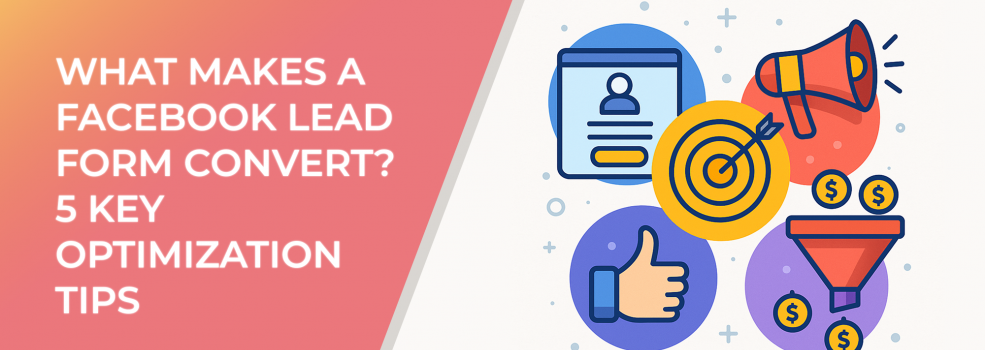Facebook Lead Ads continue to be a dominant force in the digital marketing landscape, particularly for brands focused on B2B lead generation, ecommerce, and service-based industries. These forms are designed for mobile-first interaction, reducing friction by allowing users to submit their details without leaving the platform. However, to truly scale results, it's not enough to simply use the tool; optimization is key.
Visual guide: 5 essential optimization steps to boost Facebook lead form performance
Here are five essential strategies to improve the performance of your Facebook lead form and turn clicks into qualified leads.
1. Simplify Your Form Fields for Better Completion Rates
The number and type of fields in your form can make or break your campaign. Studies show that forms with three fields or fewer have conversion rates upwards of 25%, while those with six or more drop to below 15%. Ask yourself: what information is essential at this stage of the funnel?
Use smart defaults where possible (e.g., prefilled name or email), and avoid open-ended questions unless necessary. Also consider progressive profiling—ask for additional details in future touchpoints instead of crowding the first form. This keeps the barrier to entry low while still collecting relevant data over time.
2. Craft an Offer Your Audience Can't Ignore
Your offer should speak directly to your audience's motivations. Free consultations, gated content, webinars, discount codes, and product samples are some of the most effective types of offers in lead generation. According to Salesforce, 79% of B2B buyers say they are more likely to fill out a form if there's a clearly defined incentive.
Make sure the offer matches the user intent and stage of the buyer journey. Top-of-funnel users might respond better to an educational resource, while middle-of-funnel leads could prefer a time-limited promo. Use A/B testing to compare different offers and track performance.
3. Enhance Your Copy, Creatives, and Call-to-Action
Industry benchmarks: Facebook lead ads average a conversion rate of ~8.8 % and click‑through rate of ~2.5 %, with CTR variation by sector
Your ad copy is the first point of contact and should instantly communicate value. Keep headlines under 40 characters for mobile friendliness. Use urgency ("Limited Time Offer") and relevance ("Designed for Startup Founders") to boost interest.
Visuals should reflect your brand but also stand out in the feed. Carousel ads, short-form videos, and lifestyle imagery often outperform generic stock photos. CTAs like "Download Now," "Claim Your Discount," or "Book a Free Demo" perform better than vague options like "Submit."
According to Wordstream, optimizing your ad copy and creative can increase your lead generation conversion rate by as much as 80%.
4. Maximize Engagement with a Smart Thank You Screen
The user experience doesn't end when they hit "Submit." The post-submission "Thank You" screen is a golden opportunity to nurture engagement and reduce drop-off.
Include a secondary CTA that leads users to a next step: visiting a landing page, watching a video, scheduling a call, or following your business page. According to Meta, brands that customize their Thank You screens see a 32% increase in downstream conversions.
Even better, use the screen to preview what the user can expect next—"Check your inbox for your download" or "Our team will contact you within 24 hours." This builds trust and keeps your lead warm.
5. Target Smarter with Lookalike Audiences and Custom Segments
Precise targeting can make even a basic lead form outperform a more complex one. Facebook’s Lookalike Audiences allow you to scale by finding users similar to your best existing customers.
Combine this with Custom Audiences built from pixel data, CRM lists, or website traffic. For example, targeting visitors who read your pricing page within the last 7 days can dramatically improve conversion quality.
A study by AdEspresso revealed that campaigns using Lookalike Audiences can yield up to 3x higher lead-to-sale conversion rates. Layering interest-based targeting or behavior-based signals (e.g., engaged shoppers) makes your ads even more efficient.
Pro Tips for Advanced Optimization
-
Sync With Your CRM: Use Facebook's CRM integrations or tools like Zapier to automatically sync leads and follow up within minutes.
-
Qualify Leads with Conditional Logic: Ask filter questions (e.g., budget, location) to segment leads by quality before nurturing.
-
Monitor and Adjust: Track cost per lead, lead quality, and downstream conversions—not just volume.
Using these tactics together ensures your lead form not only captures contacts but contributes to measurable business results.
Conclusion
The effectiveness of your Facebook lead form hinges on its ability to attract, engage, and convert the right audience. With proper optimization, businesses can drive high-converting leads at scale. By simplifying form fields, presenting irresistible offers, enhancing creative assets, customizing post-submission actions, and using advanced targeting like lookalike audiences, you create a streamlined and successful lead generation engine.
Whether you're looking to improve Facebook Ads ROI or reduce your cost per acquisition, these strategies provide a solid foundation for campaign growth.
Want to explore more ways to drive leads efficiently? Check out these related reads from the LeadEnforce blog:
-
Boost Your ROI by Using Meta Advantage+ Budget Automation Tools
-
Facebook Ads for SaaS Companies: How to Build Customer Acquisition Funnels
Take your paid social advertising to the next level with LeadEnforce’s precision targeting and automation tools built for modern marketers.

